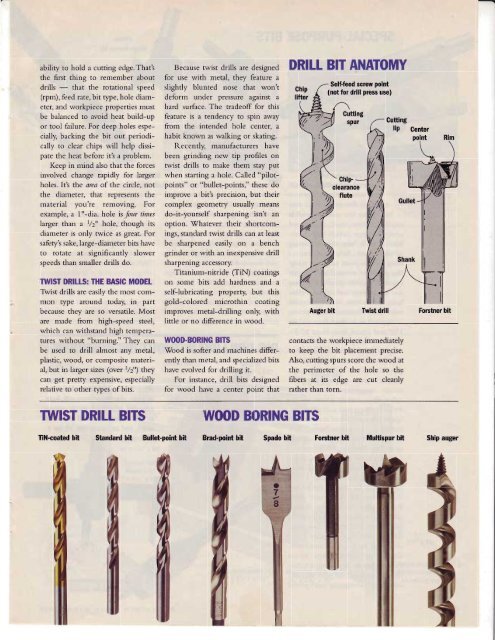Trre OnIGINAL HONAE WOOOWORKING RruN ... - Wood Tools
Trre OnIGINAL HONAE WOOOWORKING RruN ... - Wood Tools
Trre OnIGINAL HONAE WOOOWORKING RruN ... - Wood Tools
Create successful ePaper yourself
Turn your PDF publications into a flip-book with our unique Google optimized e-Paper software.
abiliry to hold a cutting edge. That's<br />
the first thing to remember about<br />
drills - that the rotational speed<br />
(rpm), feed rate, bit rype, hole diameter,<br />
and workpiece properties must<br />
be balanced to avoid heat build-up<br />
or tool failure. For deep holes especially,<br />
backing the bit out periodically<br />
to clear chips will help dissipate<br />
the heat before it's a problem.<br />
Keep in mind also that the forces<br />
involved change rapidly for larger<br />
holes. It's the area of the circle, not<br />
the diameter, that represents the<br />
material you're removing. For<br />
example, a 1"-dia. hole is four times<br />
larger than a 1/2" hole, though its<br />
diameter is only hvice as great. For<br />
safery's sake, large-diameter bits have<br />
to rotate at significantly slower<br />
speeds than smaller drills do.<br />
TWIST DRILLS: IllE BASIC M0DEL<br />
Twist drills are easily the most common<br />
rype around today, in part<br />
because they are so versatile. Most<br />
are made from high-speed steel,<br />
which can withstand high temperatures<br />
without "burning." They can<br />
be used to drill almost any metal,<br />
plastic. wood, or composite material.<br />
but in larger sizes (over l/2") Because rwist drills are designed<br />
for use with metal, they feature a<br />
slighdy blunted nose that won't<br />
deform under pressure against a<br />
hard suface. The tradeoff for this<br />
feature is a tendency to spin away<br />
from the intended hole center, a<br />
habit known as walking or skating.<br />
Recently, manufacturers have<br />
been grinding new tip profiles on<br />
rwist drills to make them stay put<br />
when starting a hole. Called "pilotpoints"<br />
or "bullet-points," these do<br />
improve a bit's precision, but their<br />
complex geometry usually means<br />
do-it-yourself sharpening isn't an<br />
option.'Whatever their shortcomings,<br />
standard rwist drills can at least<br />
be sharpened easily on a bench<br />
grinder or with an inexpensive drill<br />
sharpening accessory.<br />
Titanium-nitride (TiN) coatings<br />
on some bits add hardness and a<br />
self-lubricating properry but this<br />
gold-colored microthin coating<br />
improves metal-drilling only, with<br />
little or no difference in wood.<br />
W0OD-BORlltlG BfiS<br />
'<strong>Wood</strong><br />
is softer and machines differently<br />
than metal, and specialized bits<br />
they have evolved for drilling it.<br />
can get pretty expensive, especially For instance, drill bits designed<br />
relative to other rypes ofbits.<br />
for wood have a center point that<br />
TWIST DRILT BIili<br />
DRITL BIT ANATOMY<br />
Chip<br />
llfter<br />
Auger blt<br />
WOOD BORING BITS<br />
liil-coated bit Standard bit Bullet-point bit Brad-poirt bit Spade bit<br />
Self-feed screw polnt<br />
(not for drlll press use)<br />
Cutting<br />
spur<br />
Chlp<br />
clearance<br />
flute<br />
Twlst drlll<br />
contacts the workpiece immediately<br />
to keep the bit placement precise.<br />
Also, cutting spurs score the wood at<br />
the perimeter of the hole so the<br />
fibers at its edge are cut cleanly<br />
rather than torn.<br />
Forstner blt<br />
Forstner bit Muftispur bit Ship auger












![Til]tl](https://img.yumpu.com/45878240/1/190x245/tiltl.jpg?quality=85)




